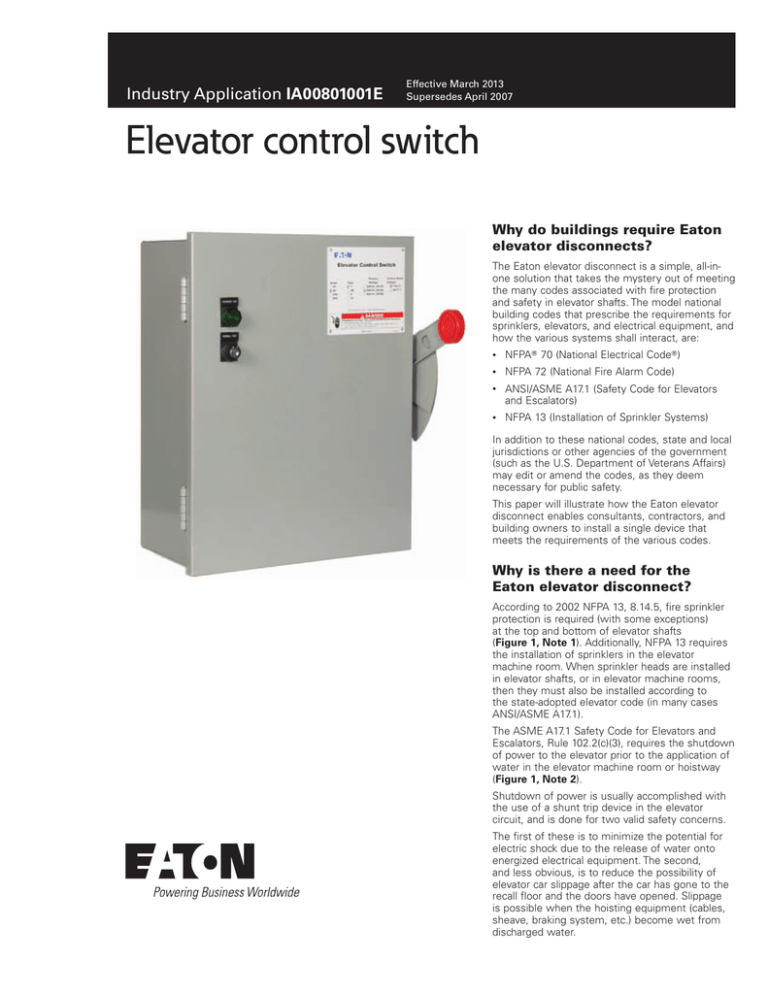
Industry Application IA00801001E
Effective March 2013
Supersedes April 2007
Elevator control switch
Why do buildings require Eaton
elevator disconnects?
The Eaton elevator disconnect is a simple, all-inone solution that takes the mystery out of meeting
the many codes associated with fire protection
and safety in elevator shafts. The model national
building codes that prescribe the requirements for
sprinklers, elevators, and electrical equipment, and
how the various systems shall interact, are:
•
NFPAT 70 (National Electrical CodeT)
•
NFPA 72 (National Fire Alarm Code)
•
ANSI/ASME A17.1 (Safety Code for Elevators
and Escalators)
•
NFPA 13 (Installation of Sprinkler Systems)
In addition to these national codes, state and local
jurisdictions or other agencies of the government
(such as the U.S. Department of Veterans Affairs)
may edit or amend the codes, as they deem
necessary for public safety.
This paper will illustrate how the Eaton elevator
disconnect enables consultants, contractors, and
building owners to install a single device that
meets the requirements of the various codes.
Why is there a need for the
Eaton elevator disconnect?
According to 2002 NFPA 13, 8.14.5, fire sprinkler
protection is required (with some exceptions)
at the top and bottom of elevator shafts
(Figure 1, Note 1). Additionally, NFPA 13 requires
the installation of sprinklers in the elevator
machine room. When sprinkler heads are installed
in elevator shafts, or in elevator machine rooms,
then they must also be installed according to
the state-adopted elevator code (in many cases
ANSI/ASME A17.1).
The ASME A17.1 Safety Code for Elevators and
Escalators, Rule 102.2(c)(3), requires the shutdown
of power to the elevator prior to the application of
water in the elevator machine room or hoistway
(Figure 1, Note 2).
Shutdown of power is usually accomplished with
the use of a shunt trip device in the elevator
circuit, and is done for two valid safety concerns.
The first of these is to minimize the potential for
electric shock due to the release of water onto
energized electrical equipment. The second,
and less obvious, is to reduce the possibility of
elevator car slippage after the car has gone to the
recall floor and the doors have opened. Slippage
is possible when the hoisting equipment (cables,
sheave, braking system, etc.) become wet from
discharged water.
Industry Application IA00801001E
Elevator control switch
Effective March 2013
The Eaton elevator disconnect is a fusible switch that is equipped
with a shunt trip mechanism. The shunt trip is operated by a control
relay (called a fire safety interface relay) in the unit that is wired to a
normally open contact in the remote fire alarm control panel (FACP).
When the FACP receives a signal from the fire alarm system
that there is going to be a sprinkler release in an elevator shaft,
a normally open contact in the FACP closes, energizing the fire
safety interface relay and completing a circuit to initiate a trip.
Sprinkler System
Sprinklers
1
The fire safety interface relay is available with a 120 Vac or a 24 Vdc
coil. The 120V coil should be selected when powered by the elevator
disconnect control circuit, and the 24V relay should be selected when
the power is supplied from the fire alarm system.
In addition to turning off power, the model codes require other
functions that are satisfied by the Eaton elevator disconnect
(Figure 1, Note 3). One of these requirements is that the shunt trip
control circuit requires monitoring. The 2002 NFPA 72 (fire alarm
code) in Section 6.15.4.4 requires:
Control circuits to shut down elevator power shall be monitored for
the presence of operating voltage. Loss of voltage to the control
circuit for the disconnecting means shall cause a supervisory signal
to be indicated at the control unit and required remote annunciation.
Thus, there is a requirement to monitor and annunciate the presence
of shunt trip control power. This is accomplished in the Eaton
elevator disconnect by the fire alarm voltage monitoring relay option.
This relay is either an SPDT or a 3PDT relay. When control power
is present, the closed relay contacts complete a circuit to the FACP
that indicates the presence of control voltage. If control voltage
is lost, the contact opens, signaling an alarm at the FACP and/or
monitoring and annunciating a single elevator; all that is required is
the single-pole relay. When wiring multiple switches (for multiple
elevators), the three-pole relay option should be chosen. However,
if there is a doubt, selecting the three-pole relay will provide all the
functionality that is needed.
1
2
3
Elevator
Disconnect
Fluid Tank
Controller
4
Battery
Lowering
Device
1 NFPA 13 requires sprinklers in
elevator shaft (with exceptions)
and in control room.
3 NFPA 72 (Fire Alarm Code)
requires control circuit for
elevator shutdown to be
monitored for the loss of voltage.
4 NEC® requires standby power
2 ASME A17.1 (Safety Code for
systems such as a battery
Elevators and Escalators) requires
lowering device to be
shutdown of power to the
disconnected by an auxiliary
elevator prior to the release
contact in the elevator disconnect.
of water.
Figure 1. Typical Hydraulic Elevator Components
and Requirements
2
eaton corporation www.eaton.com
Industry Application IA00801001E
Elevator control switch
Effective March 2013
Additional requirements and concerns
Many elevators are equipped with backup power supplies to allow
the elevator to be lowered if power is lost. For example, many
hydraulic elevators are equipped with a battery system that opens a
solenoid to lower the elevator, and then provides power to open the
elevator doors.
This battery-lowering device is viewed by the NEC as an “emergency
or standby power system,” and is governed by Article 620.91
(Figure 1, Note 4). Paragraph (C) requires that the main disconnect
be provided with an auxiliary contact that disconnects the additional
power source from the load when the disconnecting means is in the
open position. The purpose of this auxiliary contact is to disconnect
the backup power system when the elevator switch is opened
to prevent the elevator from automatically lowering while being
maintained—which would endanger maintenance personnel.
The Eaton elevator disconnect is supplied with a standard set of
1NO and 1NC auxiliary contacts that are wired to the terminal blocks
for this feature. Other manufacturers offer this as an option.
An additional concern that is not code related is accidental signaling
of a loss of voltage if a switch is turned off for maintenance or
From Feeder
testing. For example, if an Eaton elevator disconnect is turned
off to perform routine maintenance, the control voltage will be
disconnected and will send a signal to the FACP—which may alert
the local fire department and initiate a fire call.
To solve this problem, an optional micro switch mounted on the
main switch can be supplied and field-wired in parallel with the alarm
contact on the voltage monitoring relay. Wiring in this fashion would
prevent an alarm signal from being sent when the Eaton elevator
disconnect is turned off for routine maintenance.
An additional standard feature on the Eaton elevator disconnect is a
key-to-test switch to perform a functional test of the operation of the
shunt trip. A pilot light signaling that the switch is ON and a neutral
lug are the only other available options.
The available enclosures include NEMAT 1, 3R, 12, and 4 (painted),
allowing the Eaton elevator disconnect to be mounted in virtually any
standard operating environment.
In summary, the Eaton elevator disconnect is an all-in-one solution
for meeting the various codes associated with elevator shutdown
and monitoring. It is clearly the best choice for engineers and
contractors who need to provide code-compliant solutions—for
whichever code needs to be met.
1. A shunt trip device is required if the
hoistway and/or machine room is sprinklered.
L3
L2
L1
2. The location of the shunt trip device is required
to be in the elevator machine room.
Shunt Trip
Device
Shunt trip control voltage
must be monitored for
loss of voltage. Loss of
voltage is required to
activate an annunciator
on the control unit.
The building fire alarm
control unit may be
utilized for this purpose
(ref. NFPA 72 3-9.4).
To Heat Sensor(s) or
Flow Control Sensor
■ Auxiliary contact for battery lowering device
required by Art. 620-91(C). Purpose of this
contact is to distinguish between an actual
power failure and the opening of the
disconnect for maintenance.
■ Must be provided with overcurrent protection.
■ Must be lockable in the open position.
■ Must be externally operable.
Battery Lowering Device
To Elevator Controller
Figure 2. Shunt Trip Device Wiring Diagram
eaton corporation www.eaton.com
3
Industry Application IA00801001E
Elevator control switch
Effective March 2013
Elevator control switch features
Optional
Standard
•
Control power transformer with fuses and blocks
30–400A, 600 Vac, three-phase fused power switch
•
Fire safety interface relay
200,000A rms short-circuit current rating
•
Pilot light—ON
•
Shunt trip 120V
•
•
Control power terminal block
Isolated neutral lug (oversized 200% rated neutral option available
where required by excessive nonlinear loads)
Ground lug per NEC
•
•
Fire alarm voltage monitoring relay (to monitor shunt trip voltage)
•
Class J fuse mounting only (Class J fuses not included)
•
NEMA 1, 3R, 4, and 12 enclosures available through 400A
•
Key-to-test switch 120V
•
Phase failure and undervoltage relay available; consult factory
•
For added protection, use Eaton fuse covers to improve
maintenance personnel protection, through 200A
(OSHA 1910.333, Paragraph C)
•
OSHPD Special Seismic Certification Preapproval (OSP)
•
•
Mechanically interlocked auxiliary contact for hydraulic elevators
with automatic recall (5A, 120 Vac rated) 1NO, 1NC.
Table 1. Elevator Control Switch Catalog Numbering System
ES 1 T2 R2 G F1 3 N B X
X = Omit key-to-test
switch b
Prefix
ES = Elevator control switch
Control Transformer a
Ampere Rating
1 = 30A
2 = 60A
3 = 100A
4 = 200A
T2 = 208V
T3 = 240V
T1 = 480V
T4 = 600V
Fire Safety Interface Relay
(3PDT, 10A, 120V)
R2 = 24 Vdc coil
R1 = 120 Vdc coil
Pilot Light ON
G = Green
R = Red
W = White
Auxiliary Contacts
1NO/1NC
Fire Alarm Voltage
Monitoring Relay
(to Monitor Shunt Trip Voltage)
B = Main switch
F1 = Single-pole
F3 = Three-pole
Neutral Lug
N = Isolated full capacity
Enclosure Options (NEMA 1 Standard
with No Suffix Designation Required)
3 = NEMA 3R
D = NEMA 12
P = NEMA 4 painted steel
a 100 VA with primary and secondary fusing (120V secondary).
b Required by some local codes in Arizona.
For information/instructions regarding remote shunt trip
modification method to meet conflicting local codes in
some areas, please see instruction leaflet IL008003EN.
For information regarding the use of fine-stranded wire
within the elevator control switch, please see instruction
leaflet IL008004EN.
For more information regarding elevator control switches
and other Eaton switching device solutions, please go to
www.eaton.com/switches.
Eaton
1000 Eaton Boulevard
Cleveland, OH 44122 USA
Eaton.com
© 2013 Eaton
All Rights Reserved
Printed in USA
Publication No. IA00801001E / Z13469
March 2013
Eaton is a registered trademark
of Eaton Corporation.
All other trademarks are property
of their respective owners.



